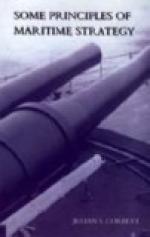What was to be done? So soon as he sighted the enemy he realised that a successful action was out of the question. Early in the morning of July 12th, “being fifteen leagues S.S.E. from Scilly,” Langara with thirty-six of the line was seen to the westward. “As soon,” wrote Howe, “as their force had been ascertained, I thought proper to avoid coming to battle with them as then circumstanced, and therefore steered to the north to pass between Scilly and the Land’s End. My purpose therein was to get to the westward of the enemy, both for protecting the Jamaica convoy and to gain the advantage of situation for bringing them to action which the difference in our numbers renders desirable.”
By a most brilliant effort of seamanship the dangerous movement was effected safely that night, and it proved an entire success. Till Howe was met with and defeated, the allies would not venture into the Channel, and his unprecedented feat had effectually thrown them off. Assuming apparently that he must have passed round their rear to seaward, they sought him to the southward, and there for a month beat up and down in ineffective search. Meanwhile Howe, sending his cruisers ahead to the convoy’s rendezvous off the south-west coast of Iceland, had taken his whole fleet about two hundred miles west of the Skelligs to meet it. Northerly winds prevented his reaching the right latitude in time, but it mattered little. The convoy passed in between him and the south of Ireland, and as the enemy had taken a cast down to Ushant, it was able to enter the Channel in safety without sighting an enemy’s sail. Ignorant of what had happened, Howe cruised for a week practising the ships “in connected movements so particularly necessary on the present occasion.” Then with his fleet in fine condition to carry out preventive tactics in accordance with Kempenfelt’s well-known exposition,[14] he returned to seek the enemy to the eastward, in order to try to draw them from their station at Scilly and open the Channel. On his way he learnt the convoy had passed in, and with this anxiety off his mind he bore up for the Lizard, where his reinforcements were awaiting him. There he found the Channel was free. From lack of supplies the enemy had been forced to retire to port, and he returned to Spithead to make preparations for the relief of Gibraltar. While this work was going on, the North Sea squadron was again strengthened that it might resume the blockade of the Texel and cover the arrival of the autumn convoys from the Baltic. It was done with complete success. Not a single ship fell into the enemy’s hands, and the campaign, and indeed the war, ended by Howe taking the mass of his force down to Gibraltar and performing his remarkable feat of relieving it in the face of the Spanish squadron. For the power and reach of a well-designed concentration there can be no finer example.
[14] See post, pp. 222-24.




